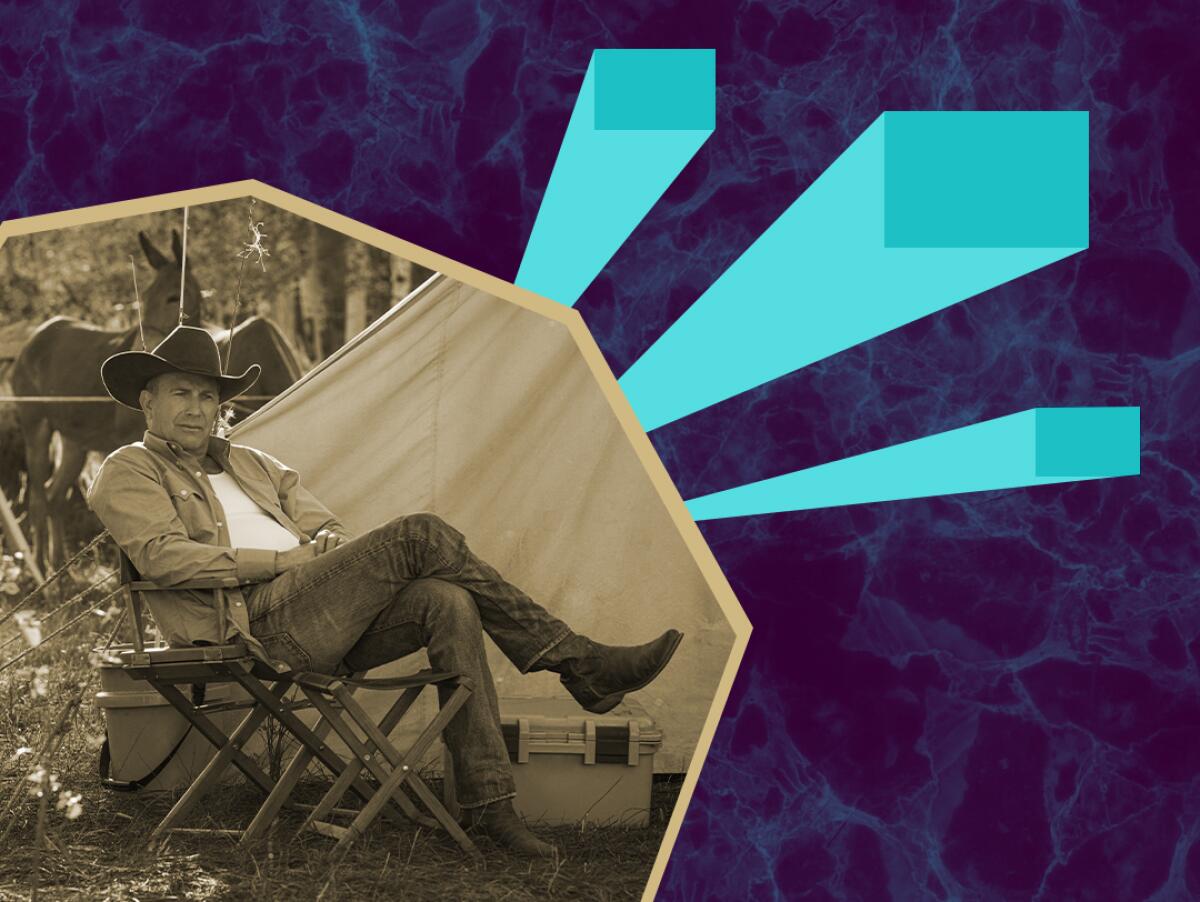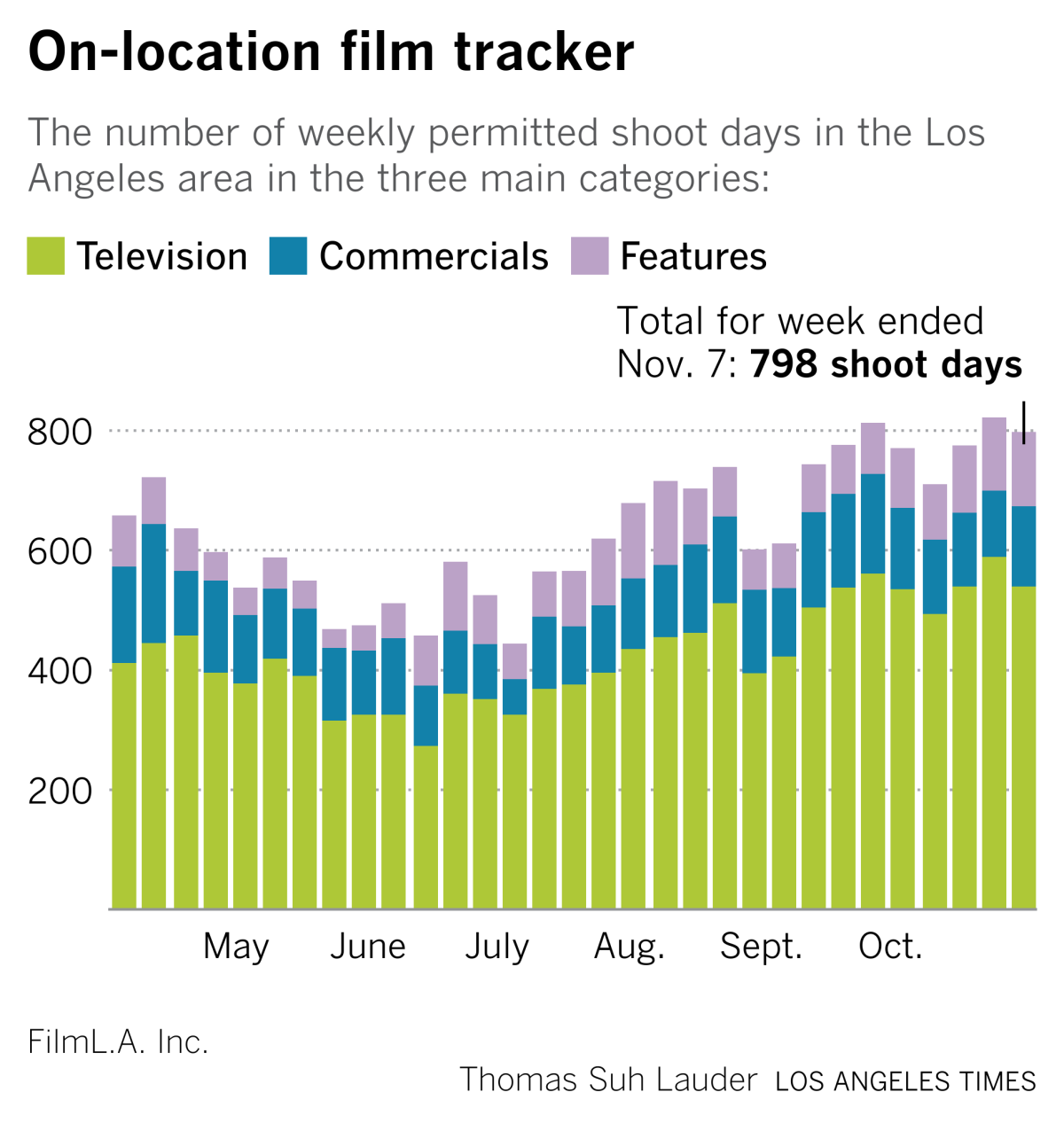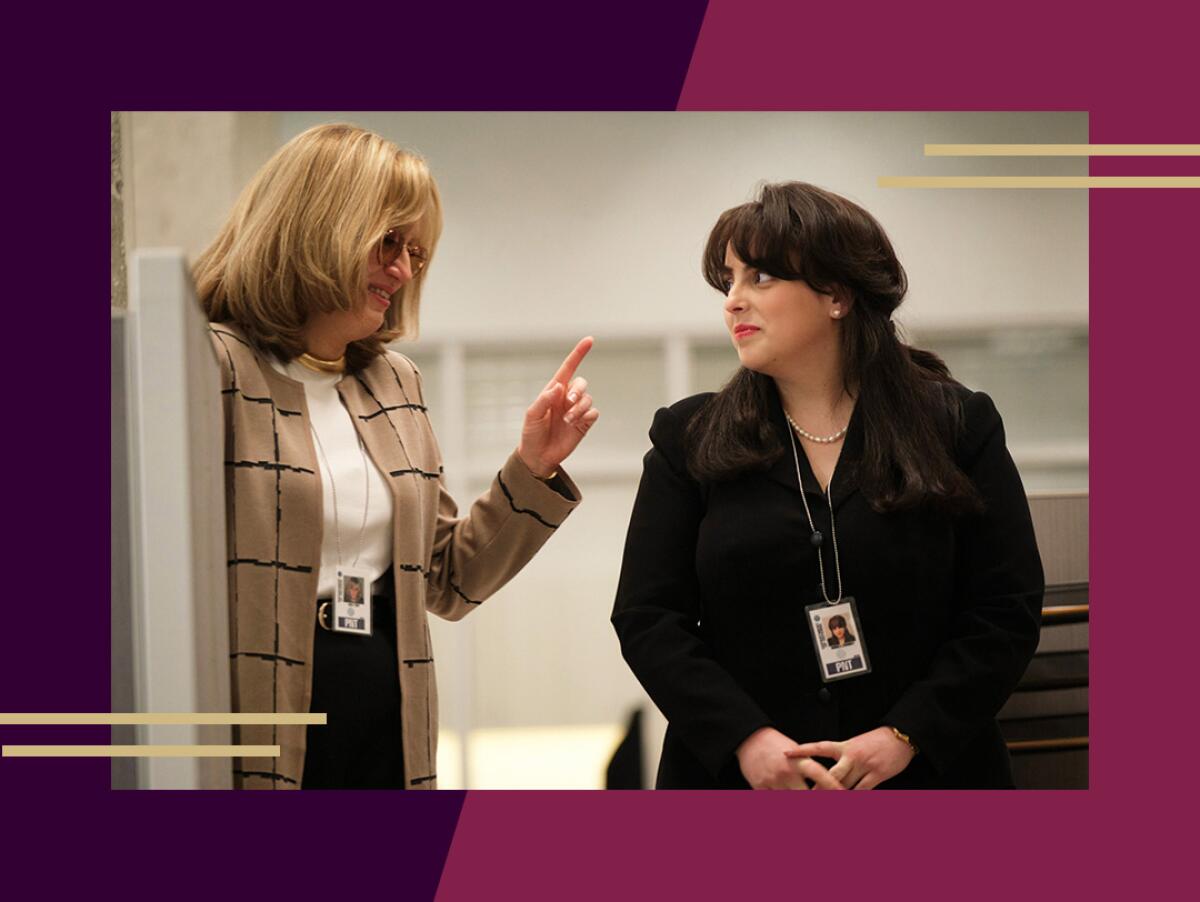‘Yellowstone’ is a hit. Can it build a ‘universe’ for Paramount+?

- Share via
This is the Nov. 9, 2021, edition of the Wide Shot, a weekly newsletter about everything happening in the business of entertainment. Sign up here to get it in your inbox.
It’s almost too easy to joke about how every entertainment franchise is a “universe” now, whether said universe is “shared,” “expanded” or “cinematic.”
Besides Marvel, the reigning franchise king, Hollywood’s expanding worlds include stories based on DC Comics, “The Conjuring,” Godzilla and King Kong (all hail the Monsterverse) and even “Bad Moms.”
With Paramount Network’s hit western cable drama “Yellowstone,” ViacomCBS hopes it has found the big bang for another universe of content that could boost subscriber numbers for streaming service Paramount+.
There’s just one problem. “Yellowstone” can’t air on Paramount+ because the streaming rights are tied up with rival Peacock (owned by Comcast’s NBCUniversal).
I wrote last week about how ViacomCBS was working around that hurdle to create a lineup of pricey “Yellowstone”-ish shows specifically for streaming. Chris McCarthy, CEO of ViacomCBS’ MTV Entertainment Group, made a deal with “Yellowstone” creator Taylor Sheridan to create a lineup of six shows — including three “Yellowstone”-adjacent programs — exclusively for the service.
One of those shows, Jeremy Renner-starring “Mayor of Kingstown,” about the American prison system, launches Sunday. Another, a “Yellowstone” prequel series titled “1883,” arrives next month.
“We decided to take the harder path,” McCarthy told me. “It would certainly be challenging, but the reward would be exceptional.”
The story has much more information on the strategy and the numbers behind “Yellowstone,” which kicked off its fourth season Sunday. ViacomCBS on Thursday said its streaming businesses, which include Paramount+ and Showtime’s over-the-top offering, added 4.3 million subscribers to reach nearly 47 million in the most recent quarter.
I also spoke with Sheridan about his vision for the growing franchise. And we got into some of his thoughts about the direction of the film and television industry. I’ve included the highlights of that conversation below, edited for length and clarity.
You previously signed an overall deal with ViacomCBS in 2020. That deal was significantly expanded in February as part of this bigger plan by the company for Paramount+. How did the larger deal come about?
What happened was, quite simply, the pandemic.
I sat down, I had nothing but time, and in four months I’d written all the scripts for my overall deal. And so I turned them all in, said, “Here you go.” And they said, “What do we do now?” And I said, “Well, I guess we’ll go make them.” And they said, “Well, we want more.” And so I said, “Let’s go figure that out.”
I think they saw an opportunity to build a bigger world. At the same time, people had a lot of time to sort of reassess, and they decided to really double down on Paramount+ and the kind of content I make. And so I talked to Chris [McCarthy at ViacomCBS] about a lot of ambitious ideas, and he bet on them.
When I spoke to Chris about this deal, he said you came back with two scripts in record time. Were the ideas already percolating for you before this deal was floated?
I wrote a number of scripts that were out of what one might consider to be my area of expertise.
With this thematic prequel to “Yellowstone” [“1883”], he really wanted to see that, and I was able to turn that around really fast. They liked my vision for it and trusted me, because it is not cheap. To re-create that world in this day and age is really, really difficult, practically.
I make 10-hour movies they show on TV. I treat them like movies. I schedule them like movies. I write all the episodes before we start filming. And I choose really ambitious locations that aren’t really conducive to the standard pattern budget.
So your TV show is going to cost more. A lot more. It’s just their belief that I’m going to turn in a quality product and they’ll benefit on the back end, because they’re not saving any money on the front end, I can promise you that.
Everything we are building set-wise is an exact re-creation of things that existed in the late 1800s, which of course then makes it more expensive, more audacious and more challenging.

ViacomCBS executives described what you guys are working on as a Taylor Sheridan “universe.” What do you make of that concept? Do you think of your shows as part of a connected universe?
I think there are themes that interest me as a storyteller, whether that is the gentrification of the West, for lack of a better term, or whether it is the failure of our penal system. I have a show we’re going to do about the oil industry and how it functions [called “Land Man”].
I’m a big believer in acting as a mirror and showing the world as it functions as accurately as I can, warts and all, so that people can make their own decisions about what they think about that world and our place in it.
You’re a feature filmmaker, and “Yellowstone” is a very cinematic series. Now you have multiple shows lined up for streaming. What effect, if any, does the method of distribution have on the storytelling?
You’d be hard pressed to find someone to give you $60 [million to] $70 million to go make a movie right now that’s not based on some kind of I.P., so you’re making a movie for $10 million or you’re making a movie for $150 million, and that one’s got people in capes.
TV has totally occupied the space that we used to call the “middle.”
I think you’re going to see more innovation between releasing something in a feature space and then immediately crossing over into a streaming platform with further stories. I think it is a really interesting use of the medium and seems like the logical evolution of it.
The experience has changed for the audience at home as well. You can go buy a 60-inch flat-screen for $400. The average viewer is not watching this on a 27-inch square anymore. They’re watching it on a 65- [to] 70-inch screen with a sound bar, having an experience that’s not a theatrical experience but is a greatly enhanced home-viewing experience, which makes it a greater challenge to get people to go to a theater.
For a lot of actors, it’s the time: 22 episodes of a traditional network show is too much time. In this 10-episode world we’re living in now, it’s such a sweet spot to really dig into a character but to also have a manageable production schedule.
Have you thought about making a “Yellowstone” feature?
No! It hadn’t even occurred to me.
Is there anything you’d like to add?
My sincere hope is that I deliver. I do feel that the model that Chris is building is the future, I really do. Since I’m the test dummy for it, I hope I survive the crash, so to speak, and deliver something worthy of the gamble.
Stuff we wrote

— The latest in our Explaining Hollywood series. How to get a job as a Hollywood animal trainer.
— On the Astroworld horror: For Travis Scott, a history of chaos at concerts, followed by a night of unspeakable tragedy.
— For three decades, goth rock singer Marilyn Manson reveled in his image as the ultimate pop-culture villain. In U.S. District Court in Los Angeles, British-born actor Esmé Bianco is waging a legal battle to prove that his menacing persona was all too real.
— More litigation over unsupported claims of voter fraud. Voting software company sues Newsmax and OAN over false election reporting.
Number of the week

We’ve written previously about how the fatal shooting of Halyna Hutchins on the set of “Rust” has put a spotlight on crew safety more broadly, not just gun-related accidents.
My colleagues Matt Stiles and Anousha Sakoui found in a review of U.S.government data and published reports that at least 19 fatal injuries took place on film sets nationwide from 2010 to 2019, the last year for which figures were available. That’s more than the 13 deaths reported during the prior decade.

From the story:
Film- and TV-related fatalities steadily declined in the 1990s and dropped to zero by 2003 as studios and producers stepped up their safety efforts and as some risky stunts were replaced with digital effects.
The industry also remains relatively safe compared with other professions.
For example, the fatal work injury rate for all industries nationwide in 2019 was 3.5 fatalities per 100,000 full-time workers, according to the U.S. Bureau of Labor Statistics. The film production industry has a rate of roughly 0.9 fatalities per 100,000 full-time workers during the last decade, The Times’ analysis found.
A total of at least 47 fatalities have occurred among 250 film production accidents since 1990. An increase in production likely contributed to the uptick in the last decade. But authorities and safety experts also say shortcuts taken by producers to save time and money have contributed to the increase in accidents on sets.
‘Rust’ updates
- After “Rust” shooting, attention turns to Georgia producers
- “Rust” tragedy highlights labor tensions in New Mexico as production surges
- “Rust” cameraman calls armorer’s sabotage allegations “dangerous” and “irresponsible”
- Dwayne Johnson says he won’t use real guns on movie sets after “Rust” shooting
- Hutchins’ husband hires L.A. law firm specializing in wrongful-death suits
Hollywood production
Combined film, TV and commercial production in the Los Angeles area dipped slightly from the previous week, when filming days hit their highest level since the pandemic began, according to data from FilmLA.

Also: Famed Universal Studios lot will add soundstages as film and TV production surges.
The Pitch: AMC pops
The Pitch is a semi-regular Wide Shot feature highlighting offbeat PR and marketing ideas and other innovations that caught our attention. This week, we look at AMC Theatres, which last week announced that it is diversifying by going into the business of selling its popcorn at retail.
AMC chief Adam Aron sees it as a new revenue stream. As The Times’ consumer columnist David Lazarus put it, AMC is betting you’ll buy its popcorn “even without a movie to watch with it” with. But it’s also clearly a brand-building endeavor. Since reopening, AMC has gone hard in the paint to beef up its brand by making commercials featuring Nicole Kidman and offering to let customers buy tickets with crypto.
Aron on Monday’s earnings call — speaking to the company’s avid meme stock shareholders — said AMC is looking into how to accept the cryptocurrency Shiba Inu, create its own crypto coin and develop commemorative movie ticket NFTs (non-fungible tokens) with the major film studios.
Will selling popcorn be a gamechanger for AMC? A major rival, Cinemark CEO Mark Zoradi, told CNBC he didn’t think so, noting that his company has been testing popcorn kiosks in malls in Brazil and has been selling prepackaged popcorn at its theaters for years. As theaters recover, the business is still all about getting people to the theater itself. That’s where the movies come in.
You should also be reading...

— The TV hit that wasn’t. There was a lot of advance hype for “Impeachment: American Crime Story.” But it won’t be available on any major streaming platform for another 10 months, and that’s a problem in 2021. (New York Times)
— “Eternals” brings something new to the Marvel Cinematic Universe: Sex. The MCU usually shies away from intimacy among superheroes, but director Chloé Zhao breaks the rules. (Wall Street Journal)
— Recommended to me by a Wide Shot reader: The 37-year-olds are afraid of the 23-year-olds who work for them. Many employers said there’s a new boldness in the way Gen Z dictates taste. (NYT)
— It’s time to stop making post-credits scenes. The firestorm surrounding (spoiler alert, I guess) Harry Styles’ arrival in the MCU shows that we’re more excited about what comes after a film than the film itself. Don’t worry, the Wide Shot knows when to stop ... (Esquire)
After the credits...
There’s a lot of good music out there right now. I keep going back to “Hey What,” the latest album from Duluth, Minn.-based indie rock band Low, and especially the gorgeous harmonies of standout track “Days Like These.”
Inside the business of entertainment
The Wide Shot brings you news, analysis and insights on everything from streaming wars to production — and what it all means for the future.
You may occasionally receive promotional content from the Los Angeles Times.




